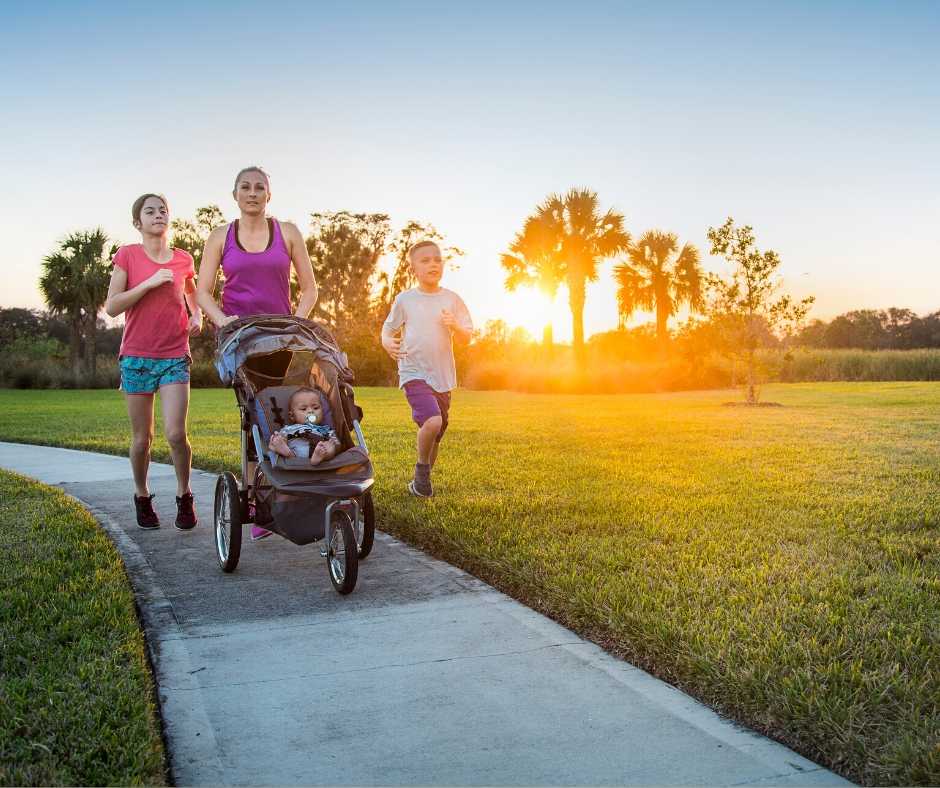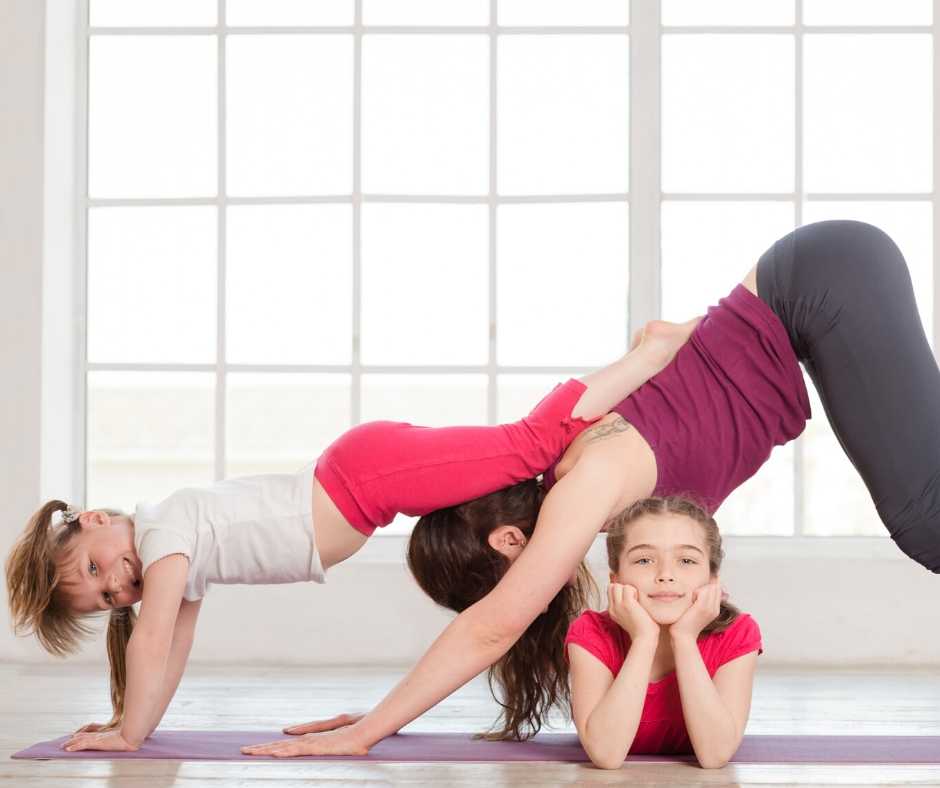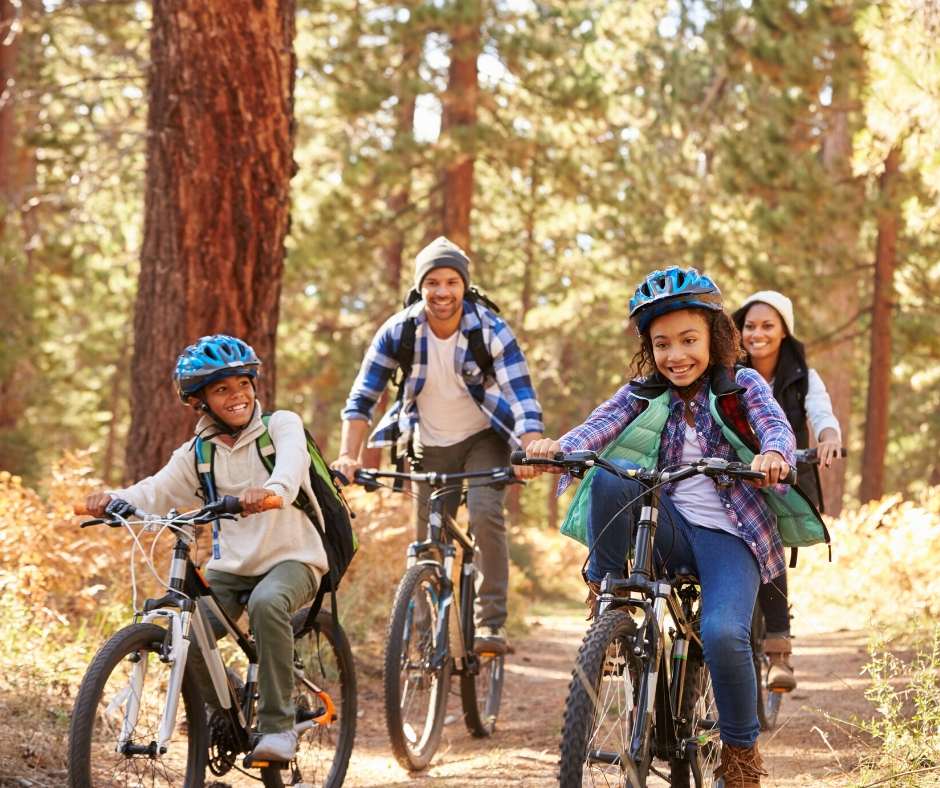When my daughter was born, our exercise was simply walking around the neighborhood as a family. Not the best, but it was a start!
We then took her for long walks through the hills in a baby carrier, but as she got older we noticed she was a bit of a homebody. She loves reading, playing quietly, and being still, so engaging her in a family exercise routine took some creativity.
We wanted to make exercising part of our family norm, especially exercising outdoors. We wanted to be good role models. And naturally, we wanted to be healthy ourselves!
It took some trial and error, but we found some fun solutions for making family exercise part of our daily routine. It was easier than we expected once we got a few things going in the right direction.

How Can My Kid Get Fit?
All parents eventually learn that the secret to raising healthy kids comes down to being a positive role model, establishing good routines, and positive reinforcement.
So, basically, it all starts with you.
Be the Role Model
In our family, we start doing things together long before we hope or expect our child to start imitating us.
We talk about health issues together. We make a point of eating healthy and talking about good versus bad eating habits. We take walks together and talk about the importance of moving our bodies and getting fresh air. It’s fun to see our daughter join the conversation and echo our opinions as if they were something she had carefully researched.
We’ve been purposefully instilling a respect for all things healthy in her from day one.
We want her self-image to become associated with enjoying doing physical activity outdoors.
We’ve made some changes to our lives recently because we want health, family, and faith to be the center of our lives. I left an overbearing job that left little time for life. And, we are now actively talking about moving to a place where living a healthy lifestyle is a priority. We talk, as a family, through these decisions because they impact what we value in life.
I look forward to the day when my daughter and I can competitively play tennis or some other sport. Until then, we make sure that our family exercise is fun for all ages. We often play by rules made up by our daughter. It’s fun to watch the joy on her face as she crosses the finish line ahead of me, even if she did have a wee bit of a head start.
When she is older, I hope these lessons will guide her choices.

Establishing A Good Family Exercise Routine
We’ve had mixed access to outdoor activities. We lived in the Pacific Northwest where it rains for what feels like an eternity ever year and in the South where its hotter than the surface of the sun during the summer. We’ve always found some way to get out of the house.
Go outdoors
Exercising indoors is great and you should definitely do this if this is your only option, but outdoors is better. This has been confirmed by multiple studies like this one by Professor Michael Depledge, Chair of Environment and Human Health at the ECEHH and this one by Harvard.
A study by Dr. Danae Lund at Sanford confirms that this is as true for children as it is for adults.
Basically, all these studies conclude that outdoors is better because its better for your mental health. So, encourage your family exercise alfresco if you want a happier family.
Why is this important when you are establishing a routine? Because it’s much easier to establish and keep a routine when it makes you happy.
Make it fun.
We make up stories during our walks, explore new “planets”, chase roly-poly bugs that we happen to encounter during our family exercise routines. Whatever makes it fun— for all the obvious reasons.
Be realistic and consistent for at least two months
While its best to go outdoors, it’s more important to be consistent and have fun. If indoors is the golden ticket that makes it happen, then stay indoors. If less exercise and more silliness works for your family, then start there. The point is to start. And, to be realistic.
Kids thrive on consistency. Your odds of successfully teaching a behavior to your child increase exponentially when your words and deeds consistently match.
But, what if you mess up? What if you miss a family exercise event? While it’s true that kids learn through repetition, studies show that a single miss here and there is less important than the general trend.
How long does it take to form a new habit? Some famous business gurus about 50 years ago popularized a myth that it takes 21 days. This made for great marketing, but there is no science to support it. Instead, science says it takes at least 66 days, perhaps much longer.
Once you’ve successfully established the routine, it will feel odd to not do it. At that point, you have set a habit that becomes self-reinforcing.
Provide Positive Reinforcement
Parents play an important role in facilitating and encouraging physical recreation at school. Whether it is to be in the audience or to be there when they come home after a loss or a win, your support is important.
While kids do like to be encouraged through positive reinforcement, be careful to not turn it into a reward system. Rewards that “pay” children for good behavior are ineffective and often backfire.
Instead of rewards, simple high-fives, praise, and hugs are the most effective ways to stimulate a positive hormone response. When used judiciously, this can help condition your child to love physical activity.
Similarly, you want to avoid unnecessary embarrassment. Not only will this take the fun out of it, but it creates a reinforcement deficit. The 5:1 ratio is a science-backed concept that says people, especially kids, need 5 positive experiences to make up for one negative one.
So, choose your words and responses wisely!

How Do I Get My Kid to Exercise More?
This “insightful” (not) government-made video suggest extending gym time, expanding the options during gym class, and increasing intensity of gym-class workout as the solution for getting kids to exercise more.
Yes, I am certain that mathematically, there is some truth to this video’s message. I can imagine the math formula someone created as their proof for this video: more time spent exercising multiplied by greater workout intensity equals more calories burned per child.
But, this line of thinking places the burden in the wrong place. Getting kids to exercise more starts with us as parents, not the schools. Yes, schools can help, but we need to lead the way. Once our family exercise stage is set, here are some tactics that might help:
Think outside of the sports box. Not everyone likes team sports. Try dancing, rock climbing, swimming, or martial arts. It may take some trial and error before you find what works for your family.
Join the game. Kids love playing with their parents. A great way to motivate children is to provide positive reinforcement by giving our time to them, especially when we get on their level by playing their games.
Limit screen time. The average American kid is estimated to consume four hours per day of screens. To have any hope of carving out a family exercise routine, you will likely have to reduce the amount of time your children spend with their phone. Fortunately, tons have been written on the topic. The only addition I will add is that it’s not just kids who can be addicted to screens. We, the parents, are sometimes guilty too, which means we will need to limit our own screen time in support of family exercise time.
Bring a friend along. Everything is better with friends!
Put your child in charge. Kids love to be the boss! Who doesn’t? The trick is to let them be in charge of choosing between the options you provide. So, go ahead, after offering suggestions of possible activities, let your child decide whether the family jumps rope or races each other.

What About for Older Children?
The above ideas may work well with younger children, but what about older kids? By the time you’re dealing with teenagers, they’re developmentally disinclined to join family activities.
This is only natural when young adults are learning to differentiate themselves from their parents. But, the same impulse draws them closer to peers, so encouraging participation in team sports can be a more promising approach.
Increasing responsibility is another strategy that teenagers can respond well to—they want autonomy. How about discussing owning a dog and have your teenager take on the responsibility for the daily walk?
What if you could use exercise to develop your relationship with them, from adult-child to an adult-adult?
How Do You Motivate Your Whole Family to Exercise?
A fun family will make exercising for kids lots of fun. So how can you have fun working some sweat up as a family?
Here are 7 ideas for family exercise:
- Go swimming together.
- Go for a family bike ride.
- Go ice skating.
- Practice yoga together.
- Play soccer—invite enough neighbor kids to form two teams and make the parents the goalies!
- Have a family workout with music to match.
- Set aside half an hour, three times a week, for fun activities together.
You get the drift—there’s lots to do once you get into the swing of it.
Gear to Help You with Exercise for Kids
The list of recreational entertainment is endless, so we’ve selected a few pieces of kids’ exercise gear to help them get their heart rates up.
- Kids/Tween/Adult Yoga Mat & Yoga Game is a fun way to improve physical awareness and gaining flexibility.
- Ninja Warrior Line Obstacle Course is great for monkeying around while getting tons of fun physical activity.
- Fitivities is a kids and family fitness exercise game that is good for all ages with 20 exercises to complete indoors or out.
- If you are looking for some good mountain bikes for your kids, then you might enjoy our review, Best Kids Mountain Bikes 2020 Guide

Workouts to Get the Whole Family Moving
Everyone needs chillout days, so don’t sweat it if your family misses its routine every now or then. Nothing is ever perfect.
What matters is starting your family exercise routine and being more consistent than not. It will take at least two months for your efforts to become a habit.
Once you have the habit, then you will have a happier, healthier life.
Why not speak with your kids today and get some ideas planted in their tiny minds? Tomorrow could be the start of a new, healthier habit!






